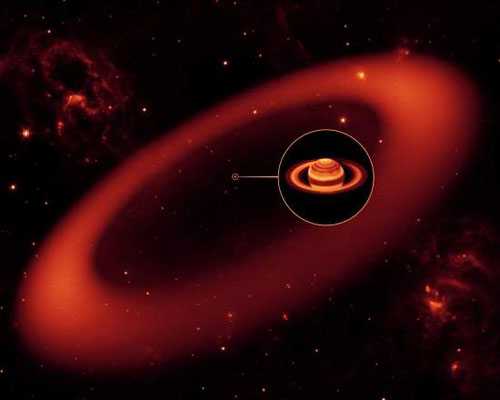Explore Saturn's new belt
The record-breaking and unprecedented giant belt discovered by Spitzer telescope. The half-dark mystery of the moon Iapetus had the answer.
Scientists have discovered the largest and unprecedented belt of Saturn. This super-sized light ring was discovered by NASA's Spitzer Telescope. The entire volume of this belt can hold about 1 billion Earths.
The belt is about 5.9 million km from Saturn and continues to expand to about 11.8 million km.
With this enormous size, many people will wonder why the belt has never been seen before. The reason is that this belt is extremely dispersed and does not reflect much visible light. However, its dust particles, though very cold, still emit infrared or thermal radiation that the Spitzer telescope can see.

Earth is just a small dot in the middle of this great belt
(Photo model: Inovacaotecnologica)
The Spitzer telescope is an infrared observatory launched in 2003. Spitzer is currently 105.6 million kilometers from Earth and revolves around the orbit of the Sun. With 85cm lens and 3 scientific devices along, it can study objects inside the solar system as well as at distant distances in the universe.
Previously, Saturn was known to have seven main rings named from A to E and countless untidy belts.
Whitney Clavin, at the NASA Jet Reaction Laboratory, said there was a band of ice and dust molecules far from the scope of the Saturn system ; including Saturn and its 61 moons. Its orbit is tilted 270 compared to Saturn's main belt system.
Although dust in the cold belt reaches -193 o C, it still emits heat radiation. Until now, no one has ever seen this belt with infrared equipment.
Phoebe moon orbit inside this belt is believed to have generated a source of material for the belt.

The Spitzer telescope has the ability to detect scattered belts (left photo);Relative sizes of Saturn and the moons;Travel is 105.6 million kilometers from Earth;Close to Saturn, the photo was taken in 2005 (right, top down)
The belt may also be the answer to the mysteries of another moon: Iapetus has a half-sphere and half a dark bridge as a yin-yang symbol. Giovanni Cassini was the first astronomer to discover the moon in 1671. Cassini Regio's half-dark bridge was named in his honor.
Belt ring orbits in the same direction as Phoebe moon while Iapetus and most of the rest of Saturn's moons rotate in the opposite direction. Scientists think the material from the outer ring has moved inside and struck Iapetus.
Astronomers have long suspected whether there is a link between the outer Phoebe moon and dark matter in Iapetus. The new belt also provided convincing evidence of this connection.

- What is Kuiper belt?
- What is asteroid belt?
- Detect invisible belt around the earth
- Into the harshest area in the universe
- 90% of people will fall back when they know the truth about the medieval virgin belt
- Create a protective belt around the Earth
- Determine the true age of Saturn's belt
- Unprecedented detailed images of Saturn's icy belt
- What's interesting on Saturn?
- Do you know who is the
- New discoveries about the Female Star
- Single way to get solar energy from the moon
 Van Allen's belt and evidence that the Apollo 11 mission to the Moon was myth
Van Allen's belt and evidence that the Apollo 11 mission to the Moon was myth The levels of civilization in the universe (Kardashev scale)
The levels of civilization in the universe (Kardashev scale) Today Mars, the sun and the Earth are aligned
Today Mars, the sun and the Earth are aligned The Amazon owner announced a secret plan to build a space base for thousands of people
The Amazon owner announced a secret plan to build a space base for thousands of people NASA spacecraft encounters mysterious ring surrounding the Solar System
NASA spacecraft encounters mysterious ring surrounding the Solar System  The NASA ship encountered a strange structure surrounding the Solar System
The NASA ship encountered a strange structure surrounding the Solar System  Where is the end of the Solar System?
Where is the end of the Solar System?  90% of people will fall back when they know the truth about the medieval virgin belt
90% of people will fall back when they know the truth about the medieval virgin belt  NASA successfully deciphered mysterious sounds in space more than 60 years ago
NASA successfully deciphered mysterious sounds in space more than 60 years ago  What is Kuiper belt?
What is Kuiper belt? 